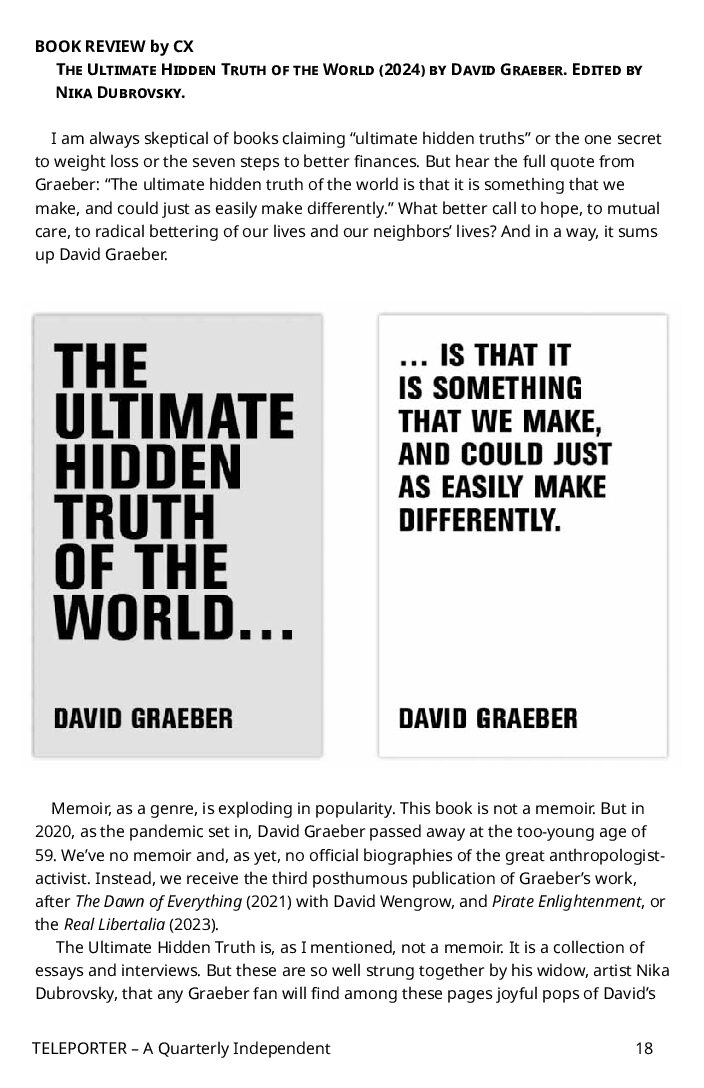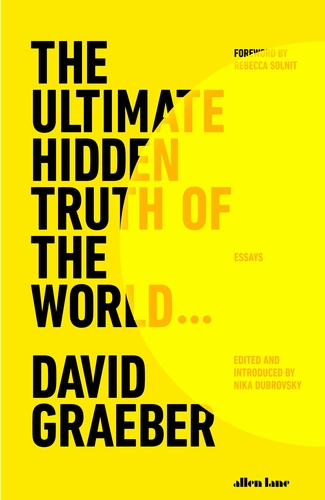
The Ultimate Hidden Truth of the World… / review by CX for Teleporter
The Ultimate Hidden Truth of the World (2024) by David Graeber. Edited by Nika Dubrovsky.
I am always skeptical of books claiming “ultimate hidden truths” or the one secret to weight loss or the seven steps to better finances. But hear the full quote from Graeber: “The ultimate hidden truth of the world is that it is something that we make, and could just as easily make differently.” What better call to hope, to mutual care, to radical bettering of our lives and our neighbors’ lives? And in a way, it sums up David Graeber.
Memoir, as a genre, is exploding in popularity. This book is not a memoir. But in 2020, as the pandemic set in, David Graeber passed away at the too-young age of 59. We’ve no memoir and, as yet, no official biographies of the great anthropologistactivist.
Instead, we receive the third posthumous publication of Graeber’s work, after The Dawn of Everything (2021) with David Wengrow, and Pirate Enlightenment, or the Real Libertalia (2023).
The Ultimate Hidden Truth is, as I mentioned, not a memoir. It is a collection of essays and interviews. But these are so well strung together by his widow, artist Nika Dubrovsky, that any Graeber fan will find among these pages joyful pops of David’s life and personality. His character shines through and embeds his theory. The result is that any reader – from experienced Graeberians, to new fans and curious peekers – is treated to rare conversations and sparkling questions, as if he’s still in the room with us.
Some of the essays are available elsewhere, and sometimes for free. Some are academic journal pieces, some interviews, others columns. Why this mix? And why repeats? Is there not enough of his writing and notes to go around? Dubvrosky reminds us, right in the introduction, that she has a mountain of notes, correspondences, drafts, interviews, and other material still to sort through.
Take a closer look. Pay careful attention to the structure of the book; it suggests a plan was enacted. Dubrovsky has put care into curating this collection. From the foreword (Rebecca Solnit) and introduction (Dubrovsky) through the final pages on fun, this tome is crafted the way it is to do one thing exceptionally well: introduce us to Graeber and his exciting, hopeful theories. It is a caring memoir, an anthropological philosophy, and an activist’s playbook all in one.
Better yet, anyone can enjoy Graeber. He is down to earth and real in his language. My only warning is for scientists who might focus on the essays culled from academic journals (e.g. Culture as Creative Refusal). Here, he starts to move at a faster clip. Graeber hopscotches through the evidence. It’s good evidence, yes, but he won’t spell everything out for you, as a social scientist might want you to; count the grains of sand on your own time. Artists might have no problem with this: Graeber, in my opinion, writes like an art theorist with a lot of anthropological data on his plate.
And that’s fine. Because he has something more important to do: He’s building truly innovative theory, an almost completely dead practice in the contemporary academy. So don’t get bogged down in tracing each bit of data. Do that later. Do it, by all means, but do it later. For now, enjoy it and keep up. There’s an exciting new philosophy bubbling, and it could mean a lot for you.
CX
—
Teleporter is an independent art newspapaer for and from Philadelphia.

